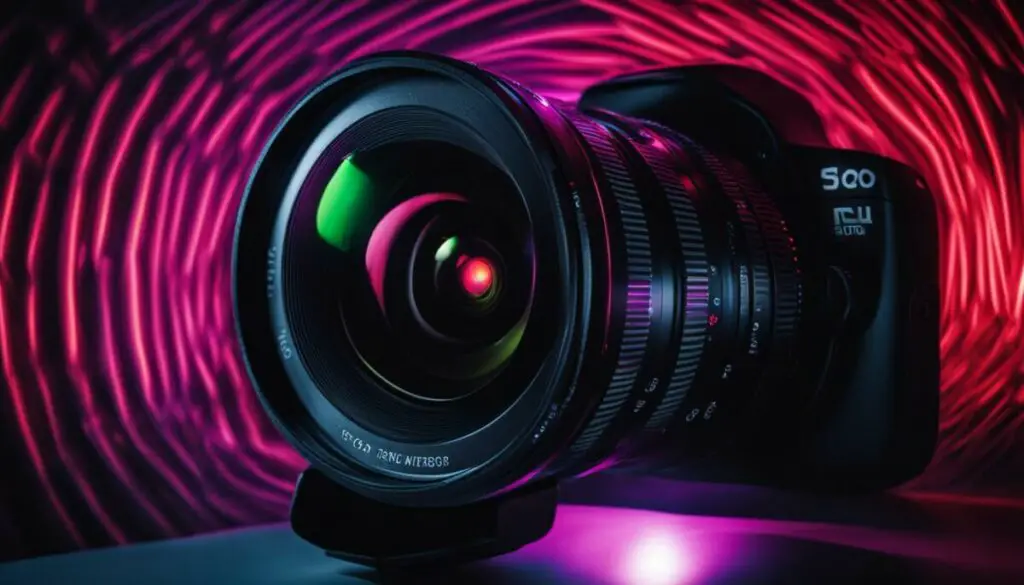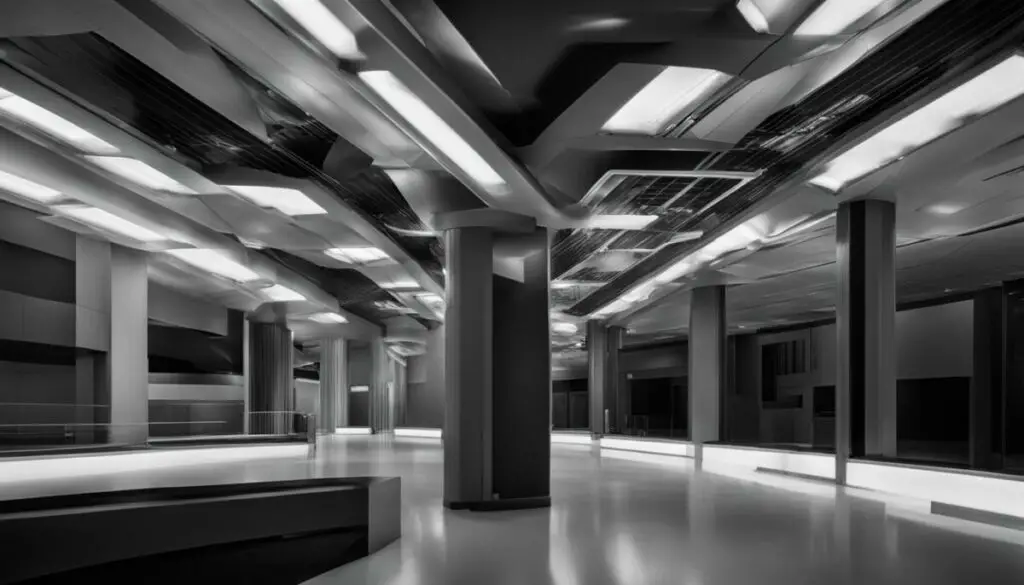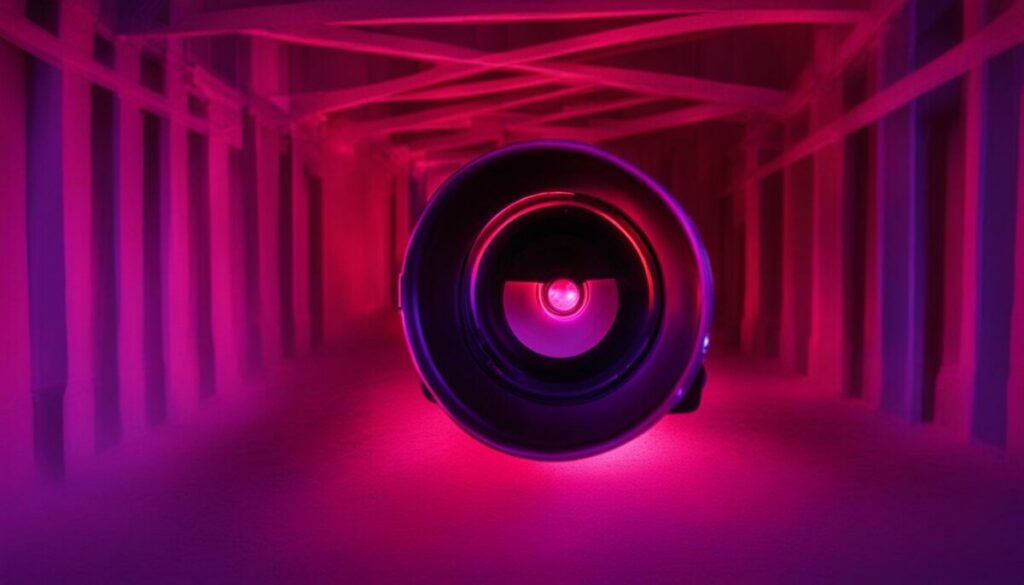Last Updated on 5 months by Francis
Infrared lights have become an important tool in various industries due to their unique properties. They emit light at a wavelength that is invisible to the human eye but visible to many cameras. As a result, they are commonly used in surveillance systems to monitor areas where visible light is not practical. However, there is a question that often arises – do infrared lights block cameras?
In this section, we will explore this question and examine the relationship between infrared lights and cameras. We will delve into the potential interference that infrared lights may have on camera visibility and recording capabilities.
Contents
Key Takeaways:
- Infrared lights emit light at a wavelength that is invisible to the human eye but visible to many cameras.
- They are commonly used in surveillance systems to monitor areas where visible light is not practical.
- The relationship between infrared lights and cameras is complex, and there is a question of whether infrared lights can block cameras.
Understanding Infrared Lights and Cameras

Infrared lights are a form of electromagnetic radiation with wavelengths longer than visible light. They are widely used in various applications, including surveillance systems and wildlife observation. Camera sensors, on the other hand, convert light into electrical signals to capture images and videos.
When it comes to infrared lights and cameras, it is important to understand how they interact with each other. Infrared lights can interfere with camera visibility and recording capabilities, leading to reduced image quality. The interference depends on various factors, such as the distance between the light source and the camera, as well as the intensity and wavelength of the infrared light.
How exactly do infrared lights affect cameras? The answer lies in the camera’s sensor technology. Most camera sensors are designed to detect visible light, which means they have limited sensitivity to infrared light. However, some cameras have special sensors that can detect infrared light, allowing them to capture images and videos even in low-light conditions.
While infrared lights can enhance camera visibility and recording quality in certain situations, they can also cause interference, making it difficult for cameras to capture clear images. Therefore, it is crucial to consider the potential impact of infrared lights on camera performance before using them for illumination or other purposes.
“Infrared lights can interfere with camera visibility and recording capabilities, leading to reduced image quality.”
Infrared Lights as Illuminators

When it comes to using infrared lights for camera blocking, it’s essential to understand their role as illuminators. Infrared lights emit light in a spectrum that is invisible to the human eye but can be detected by cameras equipped with infrared sensors. These sensors allow cameras to capture images and videos in conditions with limited visibility, such as low light or complete darkness.
Infrared lights are commonly used as illuminators in surveillance systems, wildlife observation, and security applications. They provide a reliable source of illumination without the need for visible light sources, which may alert potential intruders or disrupt wildlife behavior.
The range and intensity of infrared lights can vary depending on the intended application. For example, some infrared illuminators can provide visibility up to a few hundred feet, while others may have a shorter range. The intensity of the light can also affect its ability to illuminate a scene properly.
| Range of Infrared Lights | Intensity of Infrared Lights |
|---|---|
| Short Range: Up to 50 feet | Low Intensity: Suitable for indoor use |
| Medium Range: Up to 100 feet | Medium Intensity: Suitable for outdoor use |
| Long Range: Up to 300 feet | High Intensity: Suitable for long-range surveillance |
While infrared lights are primarily used to improve camera visibility, they can also be used to obstruct camera recording. By emitting a high-intensity infrared light, cameras can be blinded, preventing them from recording images or videos. However, this approach has limitations and may not be a foolproof solution for blocking cameras.
Infrared Light and Camera Sensors

Camera sensors are the foundation of a camera’s ability to capture images and videos, and their interaction with infrared light is crucial to understanding how infrared lights affect camera visibility. Infrared light is typically outside the range of visible light, and this is what makes it useful for surveillance systems and other applications. Camera sensors can detect some infrared light, but the sensitivity varies depending on the sensor’s design and purpose.
There are two main types of camera sensors: charge-coupled devices (CCDs) and complementary metal-oxide-semiconductor (CMOS) sensors. CCD sensors use a complex series of circuits and photodiodes to detect light, while CMOS sensors use a simpler circuit design and a single photodiode per pixel.
The Impact of Infrared Light on CCD Sensors
CCD sensors are typically more sensitive to infrared light than CMOS sensors, which can lead to potential issues with camera visibility and recording quality. The high sensitivity of CCD sensors means that they can detect infrared light even when the visible light is lacking. This can create a situation where the camera sees only the infrared light, resulting in a black and white image with limited detail. In some cases, the contrast between the different areas of the image may also be reduced, resulting in a less detailed picture.
CCD sensors can also experience blooming when exposed to strong sources of infrared light, resulting in bright spots appearing in the image. This can make it difficult to discern details in the area affected by the blooming, potentially reducing the image’s overall quality.
The Impact of Infrared Light on CMOS Sensors
CMOS sensors are generally less sensitive to infrared light than CCD sensors, which can make them more suitable for low-light environments where infrared light may be needed. However, CMOS sensors may still detect some infrared light, which can affect camera visibility and recording quality in different ways.
When CMOS sensors detect infrared light, it can cause a color shift in the image captured by the camera. This shift can result in images that appear pink or purple, reducing the image’s overall quality and accuracy. Additionally, CMOS sensors may also experience some increased noise levels when exposed to infrared light, which can further reduce image quality.
Infrared Light Sources and Camera Filters

When it comes to infrared lights and cameras, the use of camera filters and infrared light sources is an essential consideration. These components can significantly affect camera performance, influencing visibility and recording capabilities.
Camera filters are commonly used to block or enhance infrared light, allowing for greater control over camera visibility. Infrared camera filters work by absorbing or reflecting specific wavelengths of light to produce clearer or more accurate images.
Similarly, infrared light sources are used to provide illumination and enhance camera visibility in low-light environments. Infrared light sources emit light in the near-infrared spectrum, which is invisible to the human eye but detectable by camera sensors. By using an infrared light source, cameras can capture images and videos in complete darkness.
It is important to note that not all camera filters or infrared light sources are compatible with all cameras, and choosing the right components can have a significant impact on camera performance.
| Type of Component | Functionality |
|---|---|
| Infrared Camera Filters | Blocks or enhances specific wavelengths of infrared light to improve image quality |
| Infrared Light Sources | Provides illumination in low-light environments by emitting near-infrared light detectable by camera sensors |
Infrared camera filters and light sources are commonly used in surveillance systems, where visibility and recording quality are critical. However, their use can also raise concerns about privacy and security, as they can be used to identify individuals in low-light environments or to detect hidden objects or people.
In the next section, we will explore the potential interference that infrared lights may have on camera sensors and functionality.
Infrared Light Interference on Cameras
Infrared lights are commonly used as illuminators in various applications, including security cameras. However, they can potentially interfere with camera functionality and obstruct visibility. Several factors can cause interference, such as the wavelength of the infrared light, distance, and other environmental factors.
Camera sensors are designed to detect light in the visible spectrum, and their sensitivity to infrared light may vary. Some cameras are equipped with infrared-blocking filters that prevent infrared light from reaching the sensor. However, these filters may not be effective in all situations, especially when the infrared light source is powerful.
It’s essential to consider the type and intensity of the infrared light source when attempting to block cameras. For instance, low-intensity infrared lights may not obstruct the camera’s view, while high-intensity infrared lights may cause significant interference.
A study conducted by the University of Southern California found that commonly used infrared surveillance cameras could be blocked by infrared lights emitted from household bulbs. The study concluded that security cameras could be vulnerable to infrared interference, and more research is needed to understand the impact fully.
“Although infrared lights are primarily used for illumination, they can potentially interfere with camera functionality.”
When considering the use of infrared lights to block cameras, it’s crucial to understand their limitations. While infrared lights may be effective in some situations, they may not be the best option in all cases. Exploring alternative methods and technologies for camera blocking is important to ensure the desired outcomes are met.
Infrared Light and Camera Blocking: Limitations of Infrared Lights

While using infrared lights to block cameras may seem like a viable option, it has certain limitations that should be taken into consideration. In this section, we will discuss the effectiveness of using infrared lights to prevent camera recording or visibility, as well as the challenges associated with this approach.
Do IR lights prevent camera recording?
Infrared (IR) lights emit a spectrum of light that is invisible to the human eye but can be detected by cameras equipped with IR sensors. While IR lights can potentially interfere with camera visibility, they do not guarantee complete camera blocking. Cameras can still record in low light conditions by using a higher ISO setting or by adjusting the camera’s gain, which amplifies the signal from the camera sensor. This means that infrared lights alone may not be enough to prevent camera recording.
Blocking cameras with infrared technology: challenges
Another challenge associated with blocking cameras with infrared technology is the range and intensity of the IR lights. IR lights are limited in range and may not effectively cover large areas. Additionally, increasing the intensity of IR lights may result in overexposure, which can reduce the overall image quality.
Moreover, blocking cameras with infrared lights can raise concerns about legal and ethical implications. Depending on the circumstances, using infrared lights to block cameras may be illegal or unethical. Therefore, it is important to understand the legal and ethical aspects of camera blocking before employing such methods.
Alternative methods to blocking cameras
In situations where blocking cameras with infrared lights is not feasible or appropriate, there are alternative methods that can be employed. For example, physical barriers such as opaque curtains or walls can be used to prevent camera visibility. Additionally, signal jammers can interfere with wireless camera signals, preventing them from transmitting or receiving data.
It is important to note that using alternative methods to block cameras may also have limitations and should be considered on a case-by-case basis.
Overall, while infrared lights may have the potential to obstruct camera visibility, their effectiveness in blocking cameras may be limited. Understanding the relationship between infrared lights and cameras, as well as exploring alternative methods, is crucial when considering camera blocking solutions.
Infrared Lights and Cameras: Alternatives to Blocking with Infrared Technology

While infrared lights have the potential to obstruct camera visibility, there are alternative methods to prevent camera recording or visibility. Understanding these alternatives is essential when considering camera blocking solutions.
One option is to use a physical barrier to block the camera’s field of view. This can be as simple as placing an object in front of the camera or using specialized camera covers that physically block the lens. However, it is worth noting that physical barriers may not be effective in all situations, and in some cases, they may violate privacy laws.
Another option is to use radio frequency (RF) jammers to disrupt the camera’s signal. RF jammers emit a signal that interferes with the camera’s ability to receive and transmit data. While this method is effective, it is also illegal in many countries and can have severe consequences.
An emerging technology that shows promise in preventing camera recording is computer vision technology. This technology uses machine learning algorithms to analyze camera footage in real-time and identify unauthorized recording activities. Once identified, the system can trigger an alert or take action to prevent recording.
It is worth noting that while these alternatives may be effective in preventing camera recording or visibility, they also have limitations and may not be suitable for all situations. Additionally, it is important to consider the legal and ethical implications of using these methods to prevent camera recording or visibility.
Overall, while infrared lights can potentially obstruct camera visibility, there are alternative solutions to consider. Physical barriers, RF jammers, and computer vision technology are just a few examples of alternatives that may be effective in preventing camera recording or visibility. When considering camera-blocking solutions, it is essential to weigh the pros and cons of each method and consider the legal and ethical implications of using them.
Legal Considerations and Ethical Implications

Infrared lights have been used to block cameras in various situations, raising legal and ethical concerns. The legality of using infrared lights to block cameras is complex and requires careful consideration. In some cases, it may be considered a violation of the law and result in legal consequences. Therefore, it is essential to be aware of the legal implications before using infrared lights for camera blocking purposes.
Aside from legal consequences, blocking cameras with infrared lights also raises ethical concerns. It is crucial to consider the impact of such actions on privacy and individual rights. Blocking cameras may also affect the safety and security of individuals and property, and therefore must be approached with caution.
“The use of infrared lights to block cameras is a delicate issue that requires careful thought and consideration. It is important to be aware of the legal and ethical implications before taking any action.”
Additionally, it is crucial to consider the potential consequences of blocking cameras with infrared lights. While it may be a temporary solution to privacy concerns, it may not effectively address the underlying issues. Therefore, exploring alternative solutions may be a more effective approach in the long run.
In summary, using infrared lights to block cameras should be approached with caution and consideration for legal and ethical implications. It is essential to understand the potential consequences and explore alternative solutions when possible.
Industry Applications of Infrared Lights and Cameras
Infrared lights and cameras find extensive use in various industries, ranging from security and surveillance to wildlife observation and medical imaging. Here are some of the industries where infrared technology is commonly employed:
Security and Surveillance
Infrared cameras are widely used in the security and surveillance industry to monitor suspicious activities and enhance public safety. Infrared cameras can capture clear images even in low-light conditions and detect movements that might otherwise go unnoticed. Infrared illuminators are also used to provide additional light in areas that are poorly lit.
Wildlife Observation
Infrared trail cameras are commonly used by wildlife enthusiasts and researchers to study wildlife behaviors without disturbing their natural habitat. Infrared cameras can capture clear images of nocturnal animals and monitor their activities without disturbing them. Infrared technology can also be utilized to track animals in the wild or to locate injured animals that can’t be seen with the naked eye.
Medical Imaging
Infrared cameras can also be used in medical imaging to diagnose and treat patients. Infrared imaging can detect differences in temperature, allowing doctors to locate problems within the body. Infrared imaging is also useful in detecting breast cancer and other medical conditions.
Industrial Applications
Infrared technology has many industrial applications, including monitoring machinery and detecting structural deficiencies in buildings. Infrared cameras can detect heat signatures that indicate mechanical issues and help prevent costly breakdowns. Infrared technology can also be used to detect gas leaks and other environmental hazards.
As the technology continues to evolve, infrared lights and cameras will find even more applications in different industries. Understanding how infrared technology works and its applications can help individuals and organizations leverage its potential for their specific needs.
Future Developments in Infrared Technology
Infrared technology has come a long way, and it continues to evolve at a rapid pace. With more advancements and innovations, we can look forward to even more exciting applications of infrared lights and cameras.
One area of development is in the use of hyperspectral imaging in infrared technology. This technique allows for the capture of detailed images across multiple wavelengths, providing more information than traditional imaging methods. Hyperspectral imaging has the potential to revolutionize medical imaging, as it can aid in the early detection of diseases such as cancer.
Another area of innovation is in the use of artificial intelligence (AI) in infrared technology. AI algorithms can help analyze data captured by infrared cameras, identifying patterns or anomalies that may be difficult for human operators to notice. This can improve the accuracy and efficiency of infrared surveillance systems, enabling quicker and more effective responses to potential threats.
Infrared technology is also being used in unmanned aerial vehicles (UAVs) or drones for various applications such as search and rescue, surveillance, and wildlife observation. The use of infrared cameras in drones can provide high-resolution images of large areas, even in low light or nighttime conditions.
The Impact on Camera Blocking and Visibility
These advancements in infrared technology have the potential to impact camera blocking and visibility. Hyperspectral imaging, for example, may allow for the detection of hidden cameras or other surveillance devices that are not visible to the naked eye. AI algorithms can also help identify hidden cameras or other potential threats in real-time.
However, as infrared technology continues to advance, so too will the technologies used to detect and block infrared signals. This means that infrared lights may become less effective in blocking cameras as new technologies emerge.
Despite these advancements, the ethical and legal considerations surrounding camera blocking with infrared lights will remain. It is important to carefully consider the potential consequences and limitations of using infrared lights for camera blocking purposes, and to explore alternative methods and technologies.
Conclusion
To conclude, the relationship between infrared lights and cameras is complex and requires a comprehensive understanding of the technology. While infrared lights have the potential to interfere with camera visibility and recording capabilities, their effectiveness in blocking cameras may be limited.
It is important to explore alternative methods to deal with camera visibility and recording concerns. As discussed, other technologies and methods are available, such as physically blocking the lens or utilizing specialized camera filters.
Legal and Ethical Considerations
When dealing with camera blocking solutions, legal and ethical considerations must also be taken into account. While there may be situations where using infrared lights or other methods to block cameras is necessary, it is important to consider the potential consequences and implications.
Future Developments
The future of infrared technology is promising, with emerging trends and advancements that may provide more effective ways to deal with camera visibility and recording concerns. As technology continues to evolve, it is essential to stay up-to-date with the latest developments in infrared lights and cameras.
In general, understanding the relationship between infrared lights and cameras, exploring alternative methods, and considering legal and ethical implications are crucial when dealing with camera blocking solutions. With this knowledge, individuals and industries can make informed decisions about utilizing infrared technology for their unique needs and concerns.
FAQ
Do infrared lights block cameras?
Infrared lights do not block cameras, but they can potentially interfere with camera visibility and recording capabilities.
What is the relationship between infrared lights and cameras?
Infrared lights interact with camera sensors and can affect camera visibility and recording quality.
How do infrared lights function as illuminators?
Infrared lights are commonly used as illuminators in surveillance systems, but they may not necessarily obstruct camera visibility.
How does infrared light interact with camera sensors?
Infrared light can be detected by camera sensors and may impact the overall image quality.
Can infrared light be blocked or enhanced using filters?
Infrared light sources and camera filters can influence camera visibility and recording capabilities.
What factors can potentially cause interference from infrared lights?
Factors such as the wavelength of the infrared light, distance, and environmental conditions can contribute to interference.
Are infrared lights effective in blocking cameras?
While infrared lights have the potential to obstruct camera visibility, they have limitations and may not be entirely effective for blocking cameras.
What are the alternatives to blocking cameras with infrared lights?
Other methods and technologies exist to prevent camera recording or visibility, which can be explored as alternatives.
What are the legal and ethical considerations of blocking cameras with infrared lights?
Blocking cameras with infrared lights raises legal considerations and ethical implications that should be taken into account.
In what industries are infrared lights and cameras commonly used?
Infrared lights and cameras find applications in industries such as security and surveillance, wildlife observation, and medical imaging.
What are the future developments in infrared technology?
Ongoing research and advancements in infrared technology may shape the future of camera blocking and visibility solutions.
What is the conclusion regarding infrared lights and cameras?
While infrared lights can interfere with camera visibility, their effectiveness in blocking cameras may be limited. Further research and advancements in infrared technology are needed for more effective camera blocking solutions.








